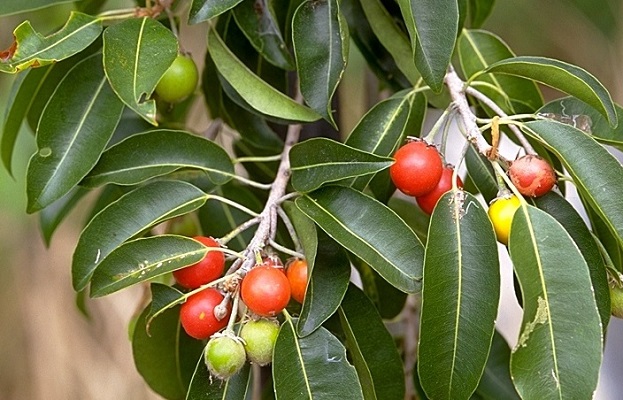On This Page
Jayapala – Croton tiglium
Introduction
Jayapala is commonly known as purging croton. It is an organic irritant plant poison. The name Jayapala denotes that the plant which cure all diseases. It is also known as Dantibeeja as the seed of the plant resembles that of plant Danti. In Ayurveda Jayapala is classified under Upavisha category. Upavishas are groups of drugs, which have toxic properties but not much potent as toxic drugs. Eventhough it shows toxic properties, it is used as a medicine in Ayurveda after proper purification. Mainly it is used for laxative purposes.
Dr. Gupta’s IAFA has been working on Jayapala plant for discovering more medicinal properties of the plant. Our experts found out that the plant can act as antihelmintic, anti-inflammatory, drastic purgative, expectorant, diaphoretic, vermifuge and carminative agent. The chemical constituents of Jayapala include linoleic acid, oleic acid and elcosenoic acid. It also contains crotonic acid, crotonic resin etc. The ethanolic extracts of the seed shows antifungal activity and thus it can be used in skin disorders.
Action of Jayapala – Croton tiglium in Allergies
IAFA has been conducting various studies on Jayapala to found out the antiallergic and anti-inflammatory properties of the plant. The plant contains phytoconstituents likelinoleic acid, oleic acid and elcosenoic acid, crotonic acid, crotonic resin, glyceryl crotonate and various carcinogenic phorbol derivatives.
Vernacular Names
| Sanskrit Name | Jayapala, Dantibeeja |
| Hindi Name | Jamalgota |
| English Name | Purging croton |
| Malayalam Name | Katalavanakku, Nirvalam |
| Kannada Name | Japala, Nepala |
| Telugu Name | Nepalamu, Nepalavemu |
Botanical Name
Croton tiglium
Family
Euphorbiaceaa
Morphology of Jayapala – Croton tiglium
- It is a small evergreen tree.
- Bark – smooth and ash colored
- Leaves – oblong to ovate – lanceolate, obtuse or rounded at the base, Yellowish green colored
- Flower – small, greenish yellow in color and unisexual
- Fruits – rounded and had 3 ridges.
- Seeds – oval and brown in color.
Ayurveda Reference of Jayapala – Croton tiglium

Geographical Distribution of Jayapala – Croton tiglium
It is distributed in South and North East parts of India.
Phytoconstituents of Jayapala – Croton tiglium
The plant contains phytoconstituents like linoleic acid, oleic acid and elcosenoic acid. It also contains crotonic acid, crotonic resin, glyceryl crotonate and various carcinogenic phorbol derivatives.
Parts Used of Jayapala – Croton tiglium
- Seed
- Seed oil
Dosage of Jayapala – Croton tiglium
- Oil (Taila) – 1 drop
- Powder (churna) – 25- 50 mg
Medicinal Properties of Jayapala – Croton tiglium
- Rechaka – purgative
- Dipana – digestant
- Krimighna – antihelminthic
- Jalodarahara – relieves ascites
- Sotha – reduces swelling
- Visaghna – removes toxicity

Have A Health Issue?
Consult Online
- Dr. Sahil Gupta (B.A.M.S., M.H.A.)
Ayurvedic Allergy Specialist
CEO & Founder of IAFA®
Home Remedies of Jayapala – Croton tiglium
Ayurvedic treatments are purely based on naturally available herbs. Jayapala is also used for treatment purposes and it can be used in diseases like,
- In Alopecia (Indralupta) – Paste of purified seeds of jayapala is applied over scalp for 7 days.
- In Erectile dysfunction – Paste of seeds of jayapala is applied over penile regions.
- In skin diseases (Kushta) – Paste of seeds of croton tiglium is applied over affected area for 7 days .
- In Generalized Swelling (sopha) – Paste of seeds of Jayapala can be given to induce purgation.
- In Asthma (Swasa) – 10 gms of seed powder is taken along with ginger juice.
- In Intestinal worms (Krimi) – 20 gms of powder of Jayapala is to be taken along with half glass of hot water.
- In snake bite – paste of seeds of Jayapala is made along with lemon juice and applied over eyes as collyrium.
- In pain and swelling – paste of seeds applied over affected area and remove after 20 minutes.
Dr. Gupta’s IAFA is one of the safest organizations to provide pure and nontoxic Ayurvedic medicines. Our treatment protocols are strictly based on Ayurvedic principles. We mainly focus on alleviating allergic disorders by using naturally available herbs which have less to no side effects. We ensure the safety of our customers by subjecting our products to various tests.
Reach IAFA for safe herbal remedies for all your ailments!!!
Was this Page Helpful?
Read More Articles

Kasini (Cichorium intybus)
Know about the uses, benefits, and medicinal properties of Chicory, Kasini (Cichorium…









